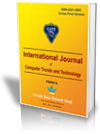Pin Point Localization Technique in Commercial Areas Using Wireless Sensor Network
 | International Journal of Computer Trends and Technology (IJCTT) |  |
| © - August Issue 2013 by IJCTT Journal | ||
| Volume-4 Issue-8 | ||
| Year of Publication : 2013 | ||
| Authors :Nitika Sharma, Manik Gupta |

Nitika Sharma, Manik Gupta"Pin Point Localization Technique in Commercial Areas Using Wireless Sensor Network"International Journal of Computer Trends and Technology (IJCTT),V4(8):2513-2517 August Issue 2013 .ISSN 2231-2803.www.ijcttjournal.org. Published by Seventh Sense Research Group.
Abstract:- Wireless Sensor Networks (WISENETs) support variety of collaborative applications such as monitoring, tracking and surveillance. Different applications demands different granularity of location information. Thus, localization is really become an important challenge in wireless sensor networks. Although, many localization techniques [2, 3, 4, 5, 11, 10] have been developed, but all of them have certain limitations like size, cost, energy efficiency, power constraints and extra hardware requirement. In this paper, we propose a Pin Point Localization Technique using virtual coordinate system to solve the problem of localization in wireless sensor network. This technique provides accurate position of an object without any cost or extra hardware requirement. Thus, the technique is energy efficient and more successful in indoor places where techniques like GPS are failed to determine the exact location.
References-
[1] Tilak, S., Kolar, V., Abu-Ghazaleh, N.B., Kang, K.D.: Dynamic localization control for mobile sensor networks. In: Proceedings of the IEEE International Workshop on Strategies for Energy Efficiency in Ad Hoc and Sensor Networks (2005).
[2] Esteves, J., Carvalho, A., Couto, C.: Generalized geometric triangulation algorithm for mobile robot absolute self-localization (2003).
[3] Wang, X., Wang, Z., O’Dea, B.: A toa-based location algorithm reducing the errors due to non-line-of-sight (nlos) propagation. IEEE Transactions on Vehicular Technology 52(1), 112–116 (2003).
[4] Eiman Elnahrawy, Xiaoyan Li and Richard P. Martin, “ The Limits of Localization Using Signal Strength: A Comparative Study, in Proceedings of IEEE SECON, pp. 406-414, Santa Clara,California, USA, October 2004.
[5]Andreas Savvides, Chih-Chieh Han, Mani B. Strivastava. Dynamic fine-grained localization in Ad-Hoc networks of sensors.MobiCom(2001).
[6] N. Bulusu, J. Heidemann, and D. Estrin, “GPS-less Low- Cost Outdoor Localization for Very Small Devices”, IEEE Personal Communication, (2000).
[7] T. He, C. Huang, B. Blum, J. Stankovic, and T. Abdelzaher, “Range-Free Localization Schemes for Large Scale Sensor Networks”, In MobiCom’03, (2003).
[8] Radhika Nagpal, Howard Shrobe, and Jonathan Bachrach, “Organizing a Global Coordinate System from Local Information on an Ad Hoc Sensor Network”, 2nd International Workshop on Information Processing in Sensor Networks (IPSN), April (2003).
[9] Dragos Niculescu and Badri Nath, “DV Based Positioning in Ad hoc Networks”, Kluwer Journal of Telecommunication Systems. (2003).
[10] B. Hofmann-Wellenhof, H. Lichtenegger, and J. Collins, “Global Positioning System: Theory and Practice”, Fourth Edition. Springer-Verlag, (1997).
[11] Dragos Niculescu and Badri Nath. Ad Hoc Positioning System (APS) Using AoA.IEEE InfoCom 2003).
Keywords : — Pin Point Localization Technique (PPLT), Wireless Sensor Network (WISENET), Sensor Nodes (SNs), Localization, Virtual Coordinate System (VCS), Global Positioning System (GPS)
